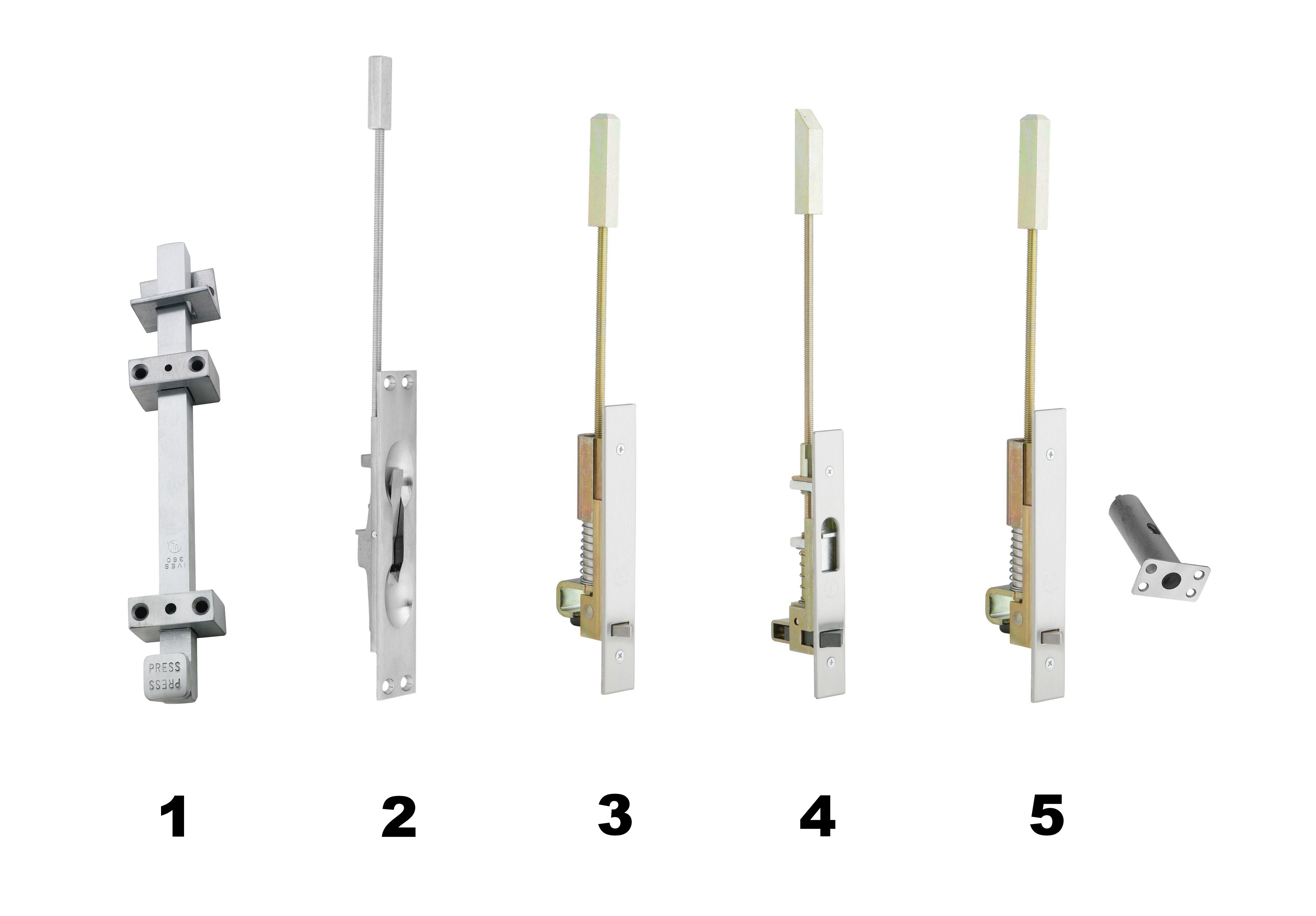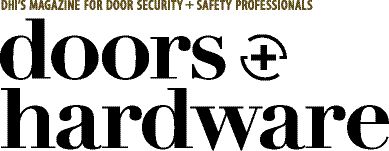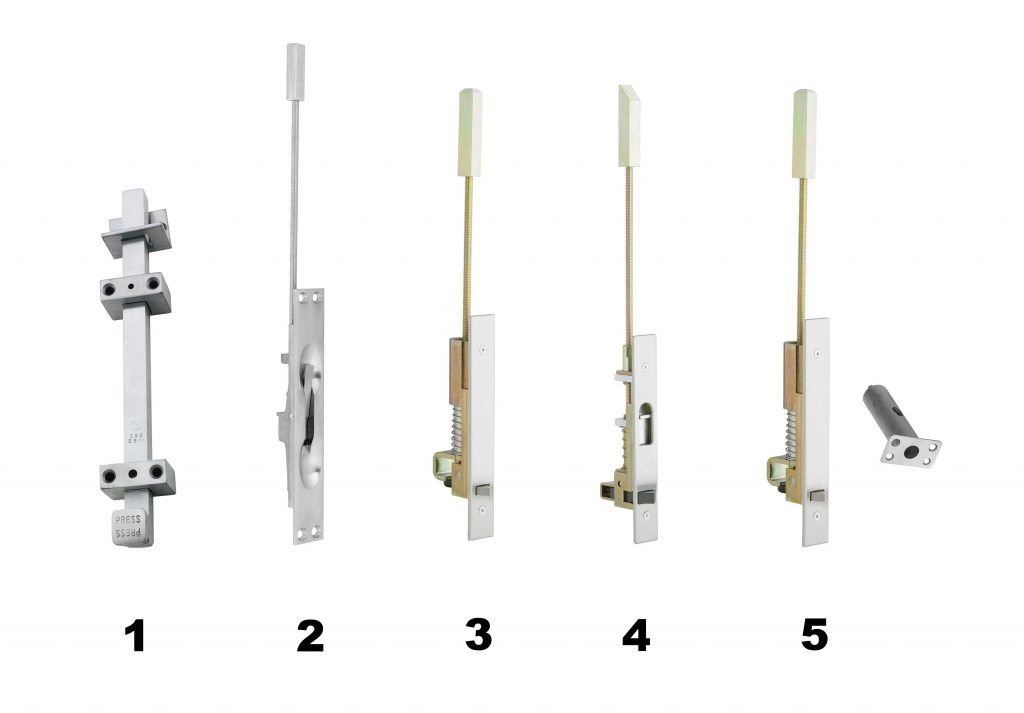This post was published in Doors & Hardware
Flush bolts are used to secure the inactive leaf of a pair of doors, projecting into the frame head and into a floor strike. In this application, the active leaf would typically have a lockset which latches into a strike mounted on the edge of the inactive leaf. Manual flush bolts and surface bolts are projected and retracted manually, and automatic flush bolts are projected when the active leaf closes and depresses a trigger on the edge of the door. When the active leaf is opened, the automatic flush bolt retracts.
Constant-latching flush bolts are a type of automatic flush bolt – the bottom bolt is a regular automatic flush bolt, but the top bolt latches when the inactive leaf closes, and stays latched until it is retracted manually. Automatic and constant-latching flush bolts are also available with a top bolt only, and an auxiliary fire pin which mounts near the bottom of the door edge and projects when a high temperature is reached during a fire.
There are several different code requirements that affect the use of flush bolts and coordinators – code requirements related to egress, fire protection, and accessibility. It’s important to consider all of the requirements that might apply to a particular pair of doors in order to determine which type of flush bolts may be used – manual, automatic, or constant-latching. If a pair of doors is required to have panic hardware, flush bolts may not be allowed
In the International Building Code (IBC), flush bolts are addressed in the section called “Bolt Locks.” There has been some confusion about whether this section is intended to apply to deadbolts, but the IBC Commentary references the inactive leaf of a pair of doors throughout this section, clarifying the intent. This section of the IBC prohibits the use of manually-operated flush bolts or surface bolts on egress doors, but includes 5 exceptions:
- Manual flush bolts or surface bolts may be used on doors in individual dwelling units or sleeping units if the doors are not required for egress.
- For doors serving storage or equipment rooms, manual flush bolts or surface bolts are permitted.
- For a pair of doors serving a business, factory and industrial, or storage occupancy with an occupant load of less than 50 people, manual flush bolts or surface bolts are allowed. This exception does not require the building to have a sprinkler system, but it only applies to the occupancy types listed here.
- For a pair of doors serving a business, factory and industrial, or storage occupancy where the building is equipped throughout with an automatic sprinkler system, manual flush bolts or surface bolts are allowed if the inactive leaf is not needed in order to meet the egress capacity requirements. For example, if the egress capacity of the active leaf is 160 occupants and the occupant load is 100 people, the inactive leaf is not needed for egress and manual flush bolts or surface bolts are acceptable. This applies only to sprinklered buildings of the referenced occupancy types.
- In a Group I-2 occupancy, such as a hospital or nursing home, patient rooms may have self-latching edge- or surface-mounted bolts if the inactive leaf is not needed to meet the egress capacity requirements. Note that this exception does not allow manually-operated bolts but does allow constant-latching automatic flush bolts.
For exceptions 3, 4, and 5, the IBC states that the inactive leaf shall not contain doorknobs, panic bars, or similar operating hardware, as this hardware could give a building occupant the impression that the inactive leaf may be operable. These exceptions were added in the 2009 edition of the IBC.
A common question is whether an inactive leaf that is provided for convenience, aesthetics, or movement of equipment, and not required for egress is allowed to have manually-operated flush bolts. This is left up to interpretation by the Authority Having Jurisdiction (AHJ) so it is difficult to predict what will be acceptable in each situation. Although the IBC Commentary seems to indicate that doors not intended for egress (including the inactive leaf of some pairs) may not be required to comply with the prohibition on manual bolts, the limitations included in items 3 and 4 above seem to indicate otherwise.
NFPA 101 – The Life Safety Code also limits the use of manual flush bolts in a means of egress, when pairs of doors are required in a means of egress. This is typically interpreted to mean that if the inactive leaf of the pair is needed in order to provide the required amount of egress capacity, manual flush bolts can not be used because they don’t meet the criteria listed in NFPA 101. When the inactive leaf is required for egress, NFPA 101 requires one of the following:
- Each leaf of the pair must have a releasing device that allows the doors to be operated independently – without depending on the release of one leaf before the other, or
- If automatic flush bolts are used, the inactive leaf shall not have surface-mounted hardware which would indicate that the door can be used for egress, and unlatching of either door leaf must not require more than one operation.
For pairs of doors that are part of a fire door assembly, additional requirements must be taken into account. One of the cardinal rules of fire doors is that they are required to be positive-latching – there must be an active latchbolt that automatically latches the door when it comes to a close. For pairs of doors this typically means that automatic flush bolts must be used, but NFPA 80 includes a potential exception to this rule. Where allowed by the AHJ, manual flush bolts or manual surface bolts may be used on pairs of fire doors as long as they do not pose a hazard to life safety. Annex A of NFPA 80 further clarifies this provision, limiting the use of manual bolts to rooms not normally occupied by humans, such as transformer vaults and storage rooms. Annex A also suggests that the inactive leaf on such pairs may not be required to have a door closer. Keep in mind that the code requirements that address elevator machine rooms typically require positive-latching hardware, and therefore manual flush bolts would not be allowed on those rooms.
It’s very important to note that NFPA 101 requires corridor doors in health care occupancies to be self-latching, stating, “Corridor doors utilizing an inactive leaf shall have automatic flush bolts on the inactive leaf to provide positive latching.” This means that the NFPA 80 exception for manual flush bolts and surface bolts does not apply to corridor doors in health care facilities that must comply with NFPA 101. For example, a pair of fire doors serving a mechanical room in a school may have manual flush bolts if acceptable to the AHJ, but a pair of fire doors serving a mechanical room in a hospital corridor is required to have automatic flush bolts if the facility is required to comply with NFPA 101.
When automatic flush bolts are used, a coordinator is typically required to ensure that the doors close in the proper sequence. If both leaves of the pair are opened and the active leaf begins to close first, the coordinator will hold the active leaf open slightly, allowing the inactive leaf to close. When the inactive leaf closes completely, it triggers the coordinator to release the active leaf and allow it to close. Coordinators may require accessories such as filler bars and mounting brackets for a complete installation. Another accessory used with flush bolts is a dust-proof strike for the bottom bolt. Although this type of strike is not required by code, it can result in a cleaner installation than the standard flush bolt strike.
Yet another concern, in addition to egress and fire protection, is accessibility. When the inactive leaf of a pair is required to meet the accessibility standards, manual flush bolts should not be used. Manual flush bolts require tight grasping and pinching to operate, and the bolts are not typically mounted within the acceptable range for operable hardware – 34 inches to 48 inches above the floor. For doors on an accessible route, automatic flush bolts or panic hardware would be a better application.
For more information about flush bolts and coordinators, refer to the applicable codes and standards, or consult the AHJ.
1 – Surface bolts are mounted on the face of the door and are operated manually.
2 – Manual flush bolts are mounted on the door edge and are projected and retracted manually using a small lever.
3 – Automatic flush bolts are projected automatically when the active leaf closes, and retracted when the active leaf opens.
4 – Constant-latching flush bolts are a type of automatic flush bolt, with a self-latching top bolt and an automatic bottom bolt.
5 – Automatic flush bolts are also available with an automatic top bolt paired with an auxiliary fire pin which projects when heated to a high temperature.
You need to login or register to bookmark/favorite this content.








You may also want to consider “key flushbolts” I find them useful on unrated doors when the door should remain open (for CPTED purposes). I used this product in a very concealed restroom along with mag holders in the outer lobby to better assure audibility out of the space (contrary to what the architect intended, but he agreed. Sometimes crime trumps bathroom sounds).
I think that the discussion of automatic and manual flush bolts might also include the topic of dummy trim on the inactive leaf.
BTW, good article Lori. You have covered this topic well, as usual.
If the door is not rated, the inactive door is not needed for egress and the active door is on a card reader; what is the preferred bolt? I was lead to believe that a constant latching or possibly automatic flush bolt was the preferred choice for security so an individual couldn’t release the manual flush bolt and defeat the card access.
Lori,
“not normally occupied by humans, such as transformer vaults and storage rooms.
Why is a Elevator Room Door considered different than a Storage Room Door?
Every Fire Rated Door Requires Positive Latching.
So, if it is okay to use Manual Flush Bolts on a Storage Room, why not at Elevator Machine Room?
Hi Moses –
Elevator machine rooms are covered by a separate code…I’m not sure what the driving factors are behind the positive-latching requirements. Maybe it’s a desire for the doors to always be secure. There’s more info about the requirements for elevator machine rooms in this post: http://idighardware.com/2014/12/elevator-machine-rooms/.
– Lori
In a fire-rated double door with constant-latching flush bolt, when is it sufficient to have a top bolt only, when are top and bottom bolts required?
Hi Nat –
Generally, you need either top and bottom bolts, or a top bolt with the auxiliary fire pin. There may be a door manufacturer who has tested with only the top bolt, but I’m not aware of one.
– Lori
Hello Lori,
Regarding Aluminum Storefront Doors, would any door leading to the exterior of the building to a public space be considered a means of egress door? In other words, if I have 2 pair doors that lead to the exterior, however only one of said pair doors is showing as the Emergency Fire Exit per the Life Safety Plan AND notes on the Door & Hardware Schedules on the building plans, does that mean I would need only need to treat the pair door showing as the Emergency Exit and thus following the building codes above OR would that apply to BOTH pair doors in my case since both lead to the exterior of the building w/public access? Please advise. Thank you!
Hi Rob –
Most exterior doors are considered egress doors, and the IBC has language stating that if more doors are provided and used for egress than the number that is required, those doors have to meet the egress requirements even though they’re “extra” doors. I think in the situation you described, most AHJs would require both pairs to meet the requirements, although they might allow one set to be omitted if there was signage clearly stating that the doors are not exits.
– Lori
Lori,
Ambulatory Health Care Occupancy and Business Occupancy can they have manual flush bolts in a door that is in a corridor that is serving a hazardous room or mechanical room the reason I ask this is in the hospital you have health car occupancies, ambulatory care occupancies and business occupancies that may be on the same floor with a fire or smoke wall separating them so does the requirement change because all I am seeing is chapter 18 new health care occupancies.
NFPA 101: Life Safety Code, 2012 Edition Chapter 18 – New Health Care Occupancies
18.3.6.3.8 Corridor doors utilizing an inactive leaf shall have automatic flush bolts on the inactive leaf to provide positive latching.
Hi Terry –
Sections 20.3.7.1 and 21.3.7.1 of the 2012 edition of NFPA 101 talk about the separation between ambulatory health care and other areas and require positive latching for those doors, but I don’t see a requirement for positive-latching corridor doors like there is in the health care chapters. With that said, NFPA 80 allows manual flush bolts “where permitted by the AHJ, provided they do not pose a hazard to safety to life.” So if these are fire doors, technically the AHJ would have to approve the use of the manual flush bolts.
– Lori
Lori,
Thank you for the information I will look at 20.3.7.1 and 21.3.7.1 I also believe that the AHJ would have to approve.
Hi Lori,
Due to some changes in design and physical constraints, in some of the areas on our project, which is classified as New Assembly occupancy, we needed to utilize “leaf and a half” option for egress doors (one 36″ leaf and other one differs from 16″ to 24″ in various locations as required by occupancy calcs).
Panic hardware is required and for these doors, most of which are fire rated, we have specified a panic push pad for full size leaf and automatic flush bolts on small leaf being led by 7.2.1.5.10-2 which you also mentioned above. However, our FLS third party reviewer is claiming that we need to have panic hardware with actuating portion of it extending for at least half width of each leaf (we only have it on bigger one and it extends for more than half of that one).
For avoidance of doubt, (almost) full clear width of door openings are required as per calculations, so therefore, both leaves.
We will change our hardware specification as they want it, but I really need to know if our initial design with auto flush bolts is NFPA compliant?
I actually also wanted to find out if same arrangement (panic hardware on one and automatic flush bolts on other) would be code compliant on typical double doors (two equal 36″ leaves)? We have provided these with independent panic hardware for general convenience and in line with 7.2.1.5.10-1, but now I just need to know if such arrangement is generally acceptable in Assembly occupancy. Even though chapter 12 does not mention auto flush bolts, it clearly states under 12.2.2.2.1 that doors complying with 7.2.1 are permitted.
Regards and thank you in advance,
Filip
Hi Lori,
If i used a double fire rated door for storage room or equipment room with manual bolt on inactive door and mortise lock on active door, is necesary to used a door clorer on inactive door?
best regards
Technically this would be up to the AHJ, but the language from NFPA 80 is here: https://idighardware.com/2016/10/wwyd-manual-flush-bolts-on-fire-rated-pairs/. Back when I wrote specifications, I did not include a closer on the inactive leaf if the pair of fire doors served a room that was not normally occupied by people.
– Lori
[…] doors. You need to know two important parts of double door locks: the flush bolt and the leaf. A flush bolt is a latch mechanism that is installed on and secures a door’s inactive […]
[…] (including constant-latching designs) do not pose many difficulties for code compliance, provided eligibility requirements are met, manual flush bolts can, as they have more stipulations that govern their […]